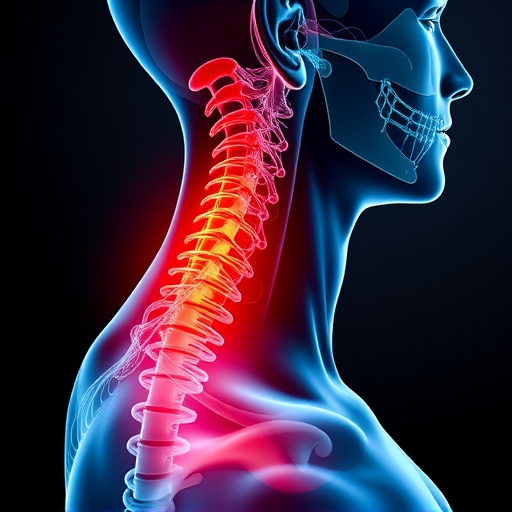Breath control is a multifaceted approach to chronic pain management, reducing inflammation and relaxing the body through deep breathing. Functional rehabilitation and spinal adjustments target specific breathing patterns to address physical dysfunctions, teaching mindful exercises for better pain perception modulation and improved overall well-being. Incorporating breathing techniques into daily routines empowers individuals to manage chronic pain effectively, reduce muscle tension, and promote physical recovery, emotional well-being, and resilience.
Chronic pain can be a debilitating condition, but breathing techniques offer a powerful tool for improvement. This article explores how controlling your breath can disrupt the cycle of pain and stress, providing a natural and effective approach to chronic pain management. By understanding the connection between breath and pain, you’ll discover techniques to calm your nervous system and integrate breathing exercises into self-care routines for enhanced well-being.
- Understanding the Link Between Breath and Pain
- Techniques to Calm the Nervous System
- Enhancing Self-Care Routines with Breathing Exercises
Understanding the Link Between Breath and Pain

Chronic pain management often involves a multifaceted approach, and one of the surprising yet powerful tools in a patient’s arsenal is their own breath. Understanding the link between breath and pain reveals a profound connection; controlled breathing can influence the body’s stress response, which in turn modulates pain perception. When we breathe deeply and slowly, we activate the parasympathetic nervous system, promoting relaxation and reducing inflammation, key factors in alleviating chronic pain symptoms.
This relationship is further reinforced by the concept of functional rehabilitation and spinal adjustment techniques that target specific breathing patterns. These rehab services not only address physical dysfunctions but also teach individuals to manage their pain through mindful breathing exercises. By integrating these practices into daily routines, patients can gain greater control over their pain levels, contributing to improved chronic pain management and overall well-being.
Techniques to Calm the Nervous System

Breathing techniques are a powerful tool to calm and regulate the nervous system, offering significant benefits for chronic pain management. When dealing with persistent pain, the body’s stress response can be heightened, leading to increased tension and discomfort. Deep breathing exercises, such as diaphragmatic or abdominal breathing, encourage relaxation by slowing heart rate and reducing cortisol levels. This, in turn, helps to ease muscle tension, a common trigger for chronic pain, including sciatica treatment.
Rehab services often incorporate these techniques into comprehensive plans to promote not just muscle recovery but also emotional well-being. By focusing on the breath, individuals can gain a sense of control over their response to pain, fostering a mindset that supports effective chronic pain management.
Enhancing Self-Care Routines with Breathing Exercises

Incorporating breathing exercises into your self-care routine can significantly enhance chronic pain management. These techniques offer a simple yet powerful way to take control of your well-being and reduce reliance on external treatments. For individuals facing persistent discomfort, especially post-injury or following shockwave therapy, learning specific breathing practices can be transformative. By focusing on the breath, you can activate your body’s natural healing mechanisms, promote relaxation, and lessen the intensity of pain signals.
Beyond its benefits for chronic pain management, this holistic approach to self-care encourages a deeper connection with one’s body. Regular practice can improve resilience during challenging times, making it an accessible and effective non-invasive treatment option. Whether incorporated into daily life or as part of a comprehensive rehabilitation plan, breathing exercises offer a calming and empowering tool for managing discomfort.
Breathing techniques have emerged as powerful tools in chronic pain management, offering a natural and accessible way to soothe the mind and body. By understanding the connection between breath and pain, individuals can harness their own innate capacity for healing. Incorporating these simple yet effective exercises into daily routines allows for better control over pain perception and promotes overall well-being. With consistent practice, these techniques can be a game-changer in navigating chronic pain.














